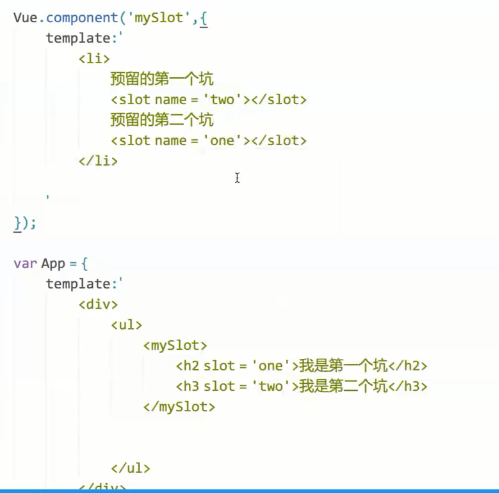1、v-for的优先级比v-if/v-show都大
v-bind也可以绑定自定义的属性
2、父组件向子组件传值
<!DOCTYPE html>
<html lang="en">
<head>
<meta charset="UTF-8">
<meta name="viewport" content="width=device-width, initial-scale=1.0">
<meta http-equiv="X-UA-Compatible" content="ie=edge">
<script src="./node_modules/vue/dist/vue.js"></script>
<title>Document</title>
</head>
<body>
<div id="app">
</div>
</body>
<script>
//全局组件
let temp={//必须先声明,然后再在其他组件中使用
template:
'<div><div v-for="(item,index) in posts">{{item.name}}</div></div>',
data(){
return{
}
},
props: ['posts']//里边的变量名务必加引号
}
new Vue({
el: '#app',//目的地
template: '<temp :posts="posts"></temp>',//在子组件中进行传值。这里的属性绑定前一个是自定义的属性名,用来在props中做名称使用
data() {
return {
posts: [{ id: 1, name: 'cc', age: 12 },
{ id: 2, name: 'ec', age: 14 },
{ id: 3, name: 'tc', age: 15 }]
}
},
components: {
temp
}
})
</script>
</html>
3、子组件向父组件传值
<!DOCTYPE html>
<html lang="en">
<head>
<meta charset="UTF-8">
<meta name="viewport" content="width=device-width, initial-scale=1.0">
<meta http-equiv="X-UA-Compatible" content="ie=edge">
<script src="./node_modules/vue/dist/vue.js"></script>
<title>Document</title>
</head>
<body>
<div id="app">
</div>
</body>
<script>
//全局组件
let temp = {//必须先声明,然后再在其他组件中使用
template:
'<div><button @click="changeSize">changeSize</button>你好吗猪妹</div>',
data() {
return {
}
},
methods: {
changeSize() {
this.$emit("change", 1)
//
}
}
}
new Vue({
el: '#app',//目的地
template: `<div :style='{fontSize:size+"em"}'><temp @change="changeHandler"></temp></div>`,//在子组件中进行传值。这里的属性绑定前一个是自定义的属性名,用来在props中做名称使用
data() {
return {
posts: [{ id: 1, name: 'cc', age: 12 },
{ id: 2, name: 'ec', age: 14 },
{ id: 3, name: 'tc', age: 15 }],
size: 1
}
},
components: {
temp
},
methods: {
changeHandler(interval) {
this.$data.size += interval
}
}
})
</script>
</html>
6、当我们使用公用组件的时候,用于公用组件的某些属性值都是一样的,导致我们在使用时不能按需修改,非常
不方便,这时候我们需要借助vue提供的slot标签,将作为分发内容的出口。
<!DOCTYPE html>
<html lang="en">
<head>
<meta charset="UTF-8">
<meta name="viewport" content="width=device-width, initial-scale=1.0">
<meta http-equiv="X-UA-Compatible" content="ie=edge">
<title>Document</title>
<script src="./node_modules/vue/dist/vue.js"></script>
</head>
<body>
<div id="app"></div>
</body>
<script>
let temp={
template: '<div><slot></slot></div>'
}
new Vue({
el: '#app',
template:"<div><temp>天气</temp><temp>运势</temp></div>",
data() {
return {
}
},
methods: {
},
components:{
temp
}
})
</script>
</html>
也可以如下图般使用:

7、过滤器
1)声明私有过滤器
filters:{
filterName:function(value){
//内部一定要return
}}
2)声明公共过滤器
Vue.filter(filterName,function(value){
return value.toLocaleUpperCase()
})
3)使用过滤器,借助管道符分隔,data就是所需要格式化的数据
{{data|fiter1(args)|filter2(args)}
8、watcher与computed
<!DOCTYPE html>
<html lang="en">
<head>
<meta charset="UTF-8">
<meta name="viewport" content="width=device-width, initial-scale=1.0">
<meta http-equiv="X-UA-Compatible" content="ie=edge">
<title>Document</title>
<script src="./node_modules/vue/dist/vue.js"></script>
</head>
<body>
<div id="app"></div>
</body>
<script>
new Vue({
el: '#app',
template: "<div>{{msg}}--------{{msg2}}</div>",
data() {
return {
msg:'天气',
arr:[]//无法监听复杂数据类型,需要进行深度监视
}
},
watch: {//一般监听单个属性
"msg":function(newV,oldV){//务必加引号
//监听属性变化,一旦改变,触发本事件
//logic
}
},
computed:{
msg2(){//虽说是函数,但是当做属性来使用
return this.msg+'变化啦'//必须return一个值,该值将作为msg2的值
}
},
})
</script>
</html>